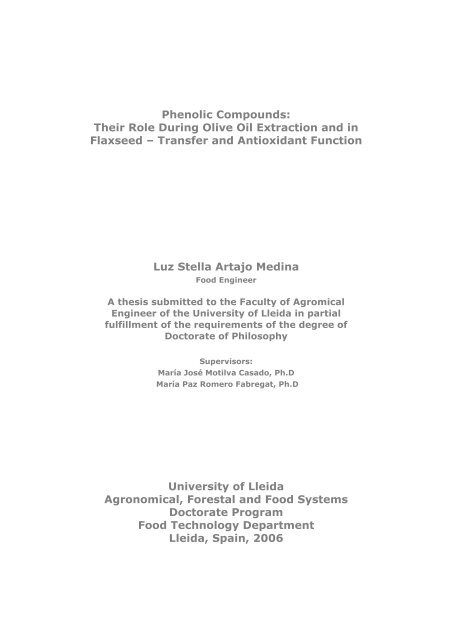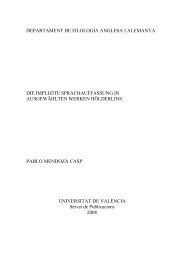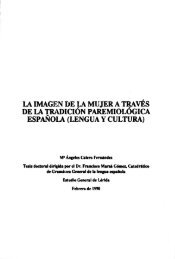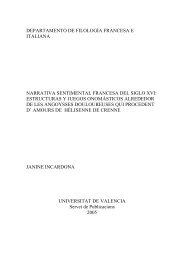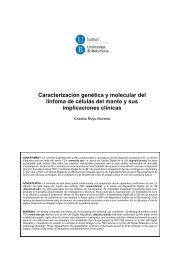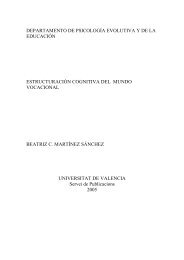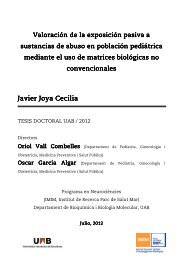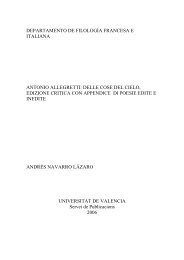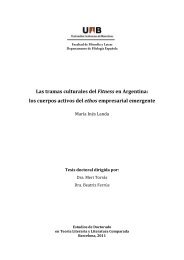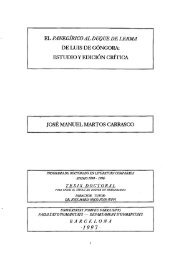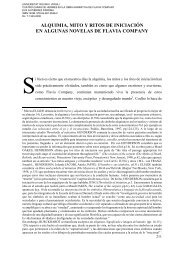Phenolic Compounds: Their Role During Olive Oil Extraction ... - Tesis
Phenolic Compounds: Their Role During Olive Oil Extraction ... - Tesis
Phenolic Compounds: Their Role During Olive Oil Extraction ... - Tesis
Create successful ePaper yourself
Turn your PDF publications into a flip-book with our unique Google optimized e-Paper software.
<strong>Phenolic</strong> <strong>Compounds</strong>:<br />
<strong>Their</strong> <strong>Role</strong> <strong>During</strong> <strong>Olive</strong> <strong>Oil</strong> <strong>Extraction</strong> and in<br />
Flaxseed – Transfer and Antioxidant Function<br />
Luz Stella Artajo Medina<br />
Food Engineer<br />
A thesis submitted to the Faculty of Agromical<br />
Engineer of the University of Lleida in partial<br />
fulfillment of the requirements of the degree of<br />
Doctorate of Philosophy<br />
Supervisors:<br />
María José Motilva Casado, Ph.D<br />
María Paz Romero Fabregat, Ph.D<br />
University of Lleida<br />
Agronomical, Forestal and Food Systems<br />
Doctorate Program<br />
Food Technology Department<br />
Lleida, Spain, 2006
Ph.D Candidate<br />
Eng. Luz Stella Artajo Medina<br />
------------------------------<br />
Signed<br />
Approval<br />
Supervisor<br />
María José Motilva Casado, Ph.D<br />
-------------------------------<br />
Signed<br />
Supervisor<br />
María Paz Romero Fabregat, Ph.D<br />
-------------------------------<br />
Signed
This Thesis was Financing Supported by<br />
“Agència de Gestió d’ Ajuts Universitaris<br />
i de Recerca-AGAUR<br />
(Generalitat de Catalunya)”<br />
And The European Social Fund
To<br />
My parents<br />
Jesús María<br />
Luz Celina<br />
My sister<br />
María del Pilar
I would like to thank…<br />
ACKNOWLEDGMENTS<br />
For the technical and scientific support:<br />
The University of Lleida (Lleida, Spain)<br />
The Agència de Gestió d’ Ajuts Universitaris i Recerca” (AGAUR)<br />
The Canadian Grain Commission (Winnipeg, Canada)<br />
María José Motilva Casado, Ph.D (University of Lleida, Spain)<br />
María Paz Romero Fabregat, Ph.D (University of Lleida, Spain)<br />
Verónique J. Barthet, Ph.D (Canadian Grain Commission, Canada)<br />
For the continued understanding of my time-consuming scientific activities:<br />
People from Fats & <strong>Oil</strong>s Laboratory (U. of Lleida)<br />
People from Applied Mycology Laboratory (U. of Lleida)<br />
People from New Technologies Laboratory (U. of Lleida)<br />
People from <strong>Oil</strong>seed Research Laboratory (Canadian Grain Commission)<br />
In general to all people - professionals and friends- Jose Morelló, Nieves Criado,<br />
Arantza Soler, Manuel Suárez, Pedro García, Neus Bellí, Ester Pardo, Ana Valero,<br />
Hector Morales, Alejandra Rojas, Pedro Elez, Angel Sobrino, Gemma Oms, Isabel
Odriozola…, who have directly or indirectly contributed to this doctoral thesis for<br />
their commendable help during these years.<br />
The same feeling of gratitude to my very good friends at home…
Content<br />
PREFACE AND JUSTIFICATION 1<br />
OBJECTIVES 4<br />
WORKING PLAN 7<br />
1. LITERATURE REVIEW 20<br />
1.1 PHENOLIC COMPOUNDS 20<br />
1.1.1. Classification 21<br />
1.1.2. Biosynthetic Origin of <strong>Phenolic</strong> <strong>Compounds</strong> 21<br />
1.2 FUNCTION OF PHENOLICS 28<br />
1.2.1 Antioxidant Function 28<br />
1.2.2 Nutritional and Sensorial Functions 33<br />
1.2.3. Biological Functions 34<br />
1.3. FACTORS AFFECTING PHENOLIC COMPOSITION 38<br />
1.3.1 Genetic Factors 39<br />
1.3.2 Agronomic Factors 39<br />
1.3.3 Postharvest Factors 40<br />
1.3.4 Tecnological Aspects – Processing 40<br />
1.4 FOOD PHENOLICS 41<br />
Pp.
Pp.<br />
1.5 OLIVE FRUIT AND VIRGIN OLIVE OIL 42<br />
1.5.1 <strong>Olive</strong> Fruit (Olea europaea L.) 42<br />
1.5.2 Virgin <strong>Olive</strong> <strong>Oil</strong> 48<br />
1.5.3 <strong>Phenolic</strong> Fraction 52<br />
1.5.4 Transformation of Biophenolic <strong>Compounds</strong> <strong>During</strong> Processing 59<br />
1.5.5 <strong>Phenolic</strong>s and Fruit Quality 60<br />
1.5.6. Biological and Nutritional Properties 62<br />
1.6 FLAXSEED 64<br />
1.6.1 Linum usitatissimun 64<br />
1.6.2 Processing of Flaxseed 66<br />
1.6.3 <strong>Phenolic</strong> Fraction 67<br />
1.6.4 Effect of Processing 69<br />
1.6.5 Biological and Nutritional Properties 70<br />
2. RESEARCH<br />
2.1 Transfer of <strong>Phenolic</strong> <strong>Compounds</strong> <strong>During</strong> <strong>Olive</strong> <strong>Oil</strong> <strong>Extraction</strong> 88<br />
in Relation to Ripening Stage of the Fruit.<br />
2.2. Effect of Irrigation Applied To <strong>Olive</strong> Trees (Olea europaea L.) 99<br />
on <strong>Phenolic</strong> Compound Transfer <strong>During</strong> <strong>Olive</strong> <strong>Oil</strong> <strong>Extraction</strong><br />
2.3 Partition of <strong>Phenolic</strong> <strong>Compounds</strong> <strong>During</strong> The Virgin <strong>Olive</strong> <strong>Oil</strong> 109<br />
Industrial <strong>Extraction</strong> Process<br />
2.4 Enrichment of Refined <strong>Olive</strong> <strong>Oil</strong> with <strong>Phenolic</strong> <strong>Compounds</strong>: 119<br />
Evaluation of <strong>Their</strong> Antioxidant Activity and <strong>Their</strong> Effect on<br />
the Bitter Index<br />
2.5 Enhancement in the Oxidative Stability of Extra Virgin <strong>Olive</strong> 130<br />
<strong>Oil</strong> Matrices by the Addition of <strong>Phenolic</strong> <strong>Compounds</strong>
2.6 Analysis of Flaxseed (Linum usitatissimum) <strong>Phenolic</strong> 141<br />
<strong>Compounds</strong><br />
Pp.<br />
2.7 Flaxseed Antioxidant System 150<br />
3. GENERAL RESULTS AND DISCUSSION 159<br />
4. CONCLUSIONS AND FUTURE RESEARCH 179<br />
ANNEXES 185<br />
I. LIST OF PAPERS 185<br />
II. TECHNOLOGICAL TRANSFER 187
Figures<br />
Figure 1. Biosynthesis of Aromatic Acids Via the Shikimic Acid Route 24<br />
Figure 2. Biosynthesis of Phenylpropanoids of Cinnamic Family and Benzoic 26<br />
Acid Derivatives and their Corresponding Alcohols from<br />
Phenylalanine and Tyrosine<br />
Figure 3. Biosynthesis of Stilbenes, Lignans, Lignins, Suberins, Cutin, 27<br />
Flavonoids, and Tannins<br />
Figure 4. Autoxidation of Polyunsaturated Fatty Acids of Lipids 30<br />
Figure 5. <strong>Olive</strong> <strong>Oil</strong> Processing Line 49<br />
Figure 6. Proposed Biosynthetic Pathway for Oleuropein in Oleacea 54<br />
Figure 7a. Chemical Structures of Secoiridoid <strong>Compounds</strong> Ocurring in <strong>Olive</strong> 56<br />
Fruit<br />
Figure 7b. Chemical Structures of <strong>Phenolic</strong> Alcohols, <strong>Phenolic</strong> Acids and 56<br />
Derivatives Ocurring in <strong>Olive</strong> Fruit<br />
Figure 7c. Chemical Structures of Flavonoids Ocurring in <strong>Olive</strong> Fruit 57<br />
Pp.
Figure 8. Chemical Structures of Lignans and Secoiridoid Derivatives 58<br />
Ocurring in <strong>Olive</strong> <strong>Oil</strong><br />
Figure 9. Proposed Biochemical Transformations of Secoiridoid into 61<br />
Derivatives<br />
Figure 10. Chemical Structures of the Main <strong>Phenolic</strong> <strong>Compounds</strong> 70<br />
Ocurring in Flaxseed<br />
Pp.<br />
Tables
Table 1. Main Classes of Plant <strong>Phenolic</strong>s 22<br />
Table 2. Biological Effects of Some Plant <strong>Phenolic</strong>s 37<br />
Table 3a. Content of Main <strong>Phenolic</strong> <strong>Compounds</strong> in Different Foods: 43<br />
Vegetables and Fruits<br />
Table 3b. Content of Main <strong>Phenolic</strong> <strong>Compounds</strong> in Different Beverages: 44<br />
Fruit Juices, Tea and Coffee<br />
Table 3c. Content of Main <strong>Phenolic</strong> <strong>Compounds</strong> in Different Beverages: 45<br />
Wines<br />
Table 4. <strong>Olive</strong> Fruit Composition 47<br />
Table 5. Quality Parameters of Virgin <strong>Olive</strong> <strong>Oil</strong> Obtained by Pressing 50<br />
and Centrifugation<br />
Table 6. Proximate Analysis of Flaxseed 66<br />
Pp.
Abstract<br />
Biophenols encompass a major group of secondary plant metabolites that display a wealth<br />
of structural variety and a large diversity of significant biological activities. An area of<br />
special interest concerning olive and flaxseed is their phenolic profile and its direct<br />
influence on the quality of derived-products and the production of potential functional<br />
foods.<br />
In response to this opportunity, the role of phenolic compounds during olive oil extraction<br />
process and their presence in flaxseed was the basis of the doctoral investigation.<br />
Two important areas: transfer and antioxidant function of phenolics during olive oil<br />
extraction were investigated. The influence of irrigation treatments, ripening index of olive<br />
fruit and different technological aspects in the production of olive oil allowed having a<br />
better understanding of the transference and transformations of the phenolic compounds.<br />
Quantitative data, in terms of transfer, were established for concentrations of phenolics in<br />
olive paste, pomace, wastewater and olive oil phases. Some of these products and by-<br />
products have been studied and proven to be effective source of phenolic antioxidants.<br />
Therefore, isolation and purification of particular phenolics were performed to evaluate<br />
their individual antioxidant activity through the oxidative stability parameter. The bitter<br />
index, a sensorial attribute, was also evaluated as function of the addition of phenolic<br />
compounds. Simple alcohols, phenolic acids, secoiridoids, secoiridoid derivatives,<br />
flavonoids and lignans were studied. The addition of the mentioned phenolic compounds<br />
on refined and extra virgin olive oil had a remarkable effect on the oxidative stability of<br />
the oils. Gallic acid, hydroxytyrosol (3,4-DHPEA), caffeic acid, luteolin and the dialdehydic<br />
form of elenolic acid linked to hydroxytyrosol (3,4-DHPEA-EDA) were found to be effective<br />
antioxidants.<br />
Flaxseed phenolic fraction was also studied. Diverse studies on the extraction of phenolics<br />
provided a basis for establishing an analytical method to evaluate the phenolic composition<br />
of flax. A solvent extraction followed by hydrolysis treatments resulted in the identification<br />
of the main phenolic compounds occurred in flaxseed including secoisolariciresinol<br />
diglycoside (SDG). A subsequent study to understand the flaxseed antioxidant system was<br />
developed using reconstituted flour meals with commercial oil and analyzing hulls and<br />
dehulled flour meals. Peroxide and aldehyde values were determined during two weeks of<br />
storage. It appeared that SDG and phenolic acids (ferulic and p-coumaric glycosides)<br />
might not be responsible of the main flaxseed antioxidant function.
Resumen<br />
Los biofenoles abarcan un amplio grupo de metabolitos secundarios de diversa estructura y<br />
reconocida actividad biológica. Específicamente el interés en el fruto de la oliva y en la semilla de<br />
lino está relacionado con su perfil fenólico y con su influencia directa en la calidad de productos<br />
derivados, así como con su posible uso en la producción de alimentos funcionales.<br />
Como respuesta a este reciente planteamiento, la tesis doctoral se centró en la investigación del<br />
papel de los compuestos fenólicos en el proceso de extracción de aceite de oliva y en la semilla<br />
de lino.<br />
Se tuvieron en cuenta dos importantes aspectos: la transferencia y la función antioxidante de los<br />
compuestos fenólicos implicados en el proceso de obtención de aceite de oliva. La influencia de<br />
tratamientos de irrigación, el índice de madurez y otros asuntos tecnológicos del procesamiento<br />
del fruto de la oliva trajeron como consecuencia un mejor entendimiento de la transferencia y<br />
transformación de los compuestos fenólicos. Se determinaron, entonces, datos cualitativos y<br />
cuantitativos en términos de transferencia, correspondientes a las concentraciones de fenoles en<br />
la pasta de oliva, orujo, alpechín y aceite de oliva. Algunos de estos productos y subproductos se<br />
han reconocido como valiosa fuente de compuestos antioxidantes. Por esta razón se procedió al<br />
aislamiento y purificación de determinados fenoles con el fin de evaluar su capacidad<br />
antioxidante a través del parámetro de estabilidad oxidativa. Igualmente se determinó el efecto<br />
de los compuestos fenólicos sobre el atributo sensorial de índice de amargor. Se estudiaron<br />
alcoholes simples, ácidos fenólicos, secoiridoides, derivados secoiridoides, flavonoides y<br />
lignanos, encontrándose un significativo efecto al adicionar dichos compuestos a distintas<br />
matrices de aceite de oliva (refinado y extra virgen). El ácido gálico, el hidroxitirosol (3,4-<br />
DHPEA), el ácido cafeico, la luteolina y la forma dialdehídica del ácido elenólico ligada al<br />
hidroxitirosol (3,4-DHPEA-EDA), mostraron tener efectividad como antioxidantes.<br />
De igual forma se investigó la semilla de lino en función de su composición fenólica. La<br />
existencia de disímiles métodos de extracción de los fenoles se convirtió en el punto de partida<br />
para el estudio analítico de la fracción fenólica de la linaza. La extracción con solventes<br />
orgánicos, seguida de un proceso de hidrólisis, permitió la identificación de los principales<br />
compuestos característicos de la semilla de lino, como el Secoisolariciresinol diglucosídico (SDG).<br />
Posteriormente se pasó al estudio del sistema antioxidante de la linaza, para lo cual se evaluó el<br />
contenido de peróxidos y aldehídos en muestras de harina de semilla reconstituidas con aceite<br />
comercial de lino después de una y dos semanas de almacenamiento. También se analizaron<br />
harinas procedentes de semilla sin cascarilla y con cascarilla. La investigación preliminar permitió<br />
concluir que el SDG y otros compuestos, tales como las formas glucosídicas de los ácidos ferúlico<br />
y p-cumárico, no están implicados directamente en el sistema responsable de los procesos<br />
antioxidantes de la semilla de lino.
Resum<br />
Els biofenols comprenen un gran grup de metabòlits secundaris que presenten una àmplia<br />
varietat d’estructures i una gran diversitat d’activitats biològiques. Específicament, l’interès en<br />
l’oliva i la llavor del lli (llinassa) està relacionat amb el seu perfil fenòlic i amb la influència<br />
directa d’aquest en la qualitat de productes derivats, Així com en el possible ús en aliments<br />
funcionals.<br />
Com a resposta a aquest plantejament, la tesi s’ha centrat a la investigació del paper dels<br />
compostos fenòlics durant el procés d’extracció de l’oli d’oliva i de llinassa.<br />
Es van tenir en compte dos importants aspectes: la transferència i les funcions antioxidants dels<br />
compostos fenòlics relacionats en el procés d’obtenció d’oli d’oliva. La influència dels tractaments<br />
d’irrigació, de l’índex de maduració i d’altres aspectes tecnològics del processament de l’oliva es<br />
traduí en un millor enteniment de la transferència i transformació dels compostos fenòlics.<br />
S’establiren les concentracions de fenols, en termes de transferència, corresponents a les<br />
fraccions de pasta d’oliva, pinyola, oliassa i oli d’oliva. Es reconegueren alguns d’aquests<br />
productes i subproductes com a valuosa font de compostos antioxidants. És per això que es va<br />
procedir a l’aïllament i purificació de determinats fenols amb la finalitat d’avaluar la seva<br />
capacitat antioxidant a través del paràmetre d’estabilitat oxidativa. També es va determinar<br />
l’efecte dels compostos fenòlics sobre l’atribut sensorial “índex d’amargor”. Es van estudiar els<br />
alcohols simples, àcids fenòlics, secoiridoids, derivats secoiridoids, flavonoids i lignans. Es trobà<br />
un efecte significatiu a l’addicionar aquests compostos sobre diferents matrius d’oli d’oliva<br />
(refinat i verge extra). L’àcid gàlic, l’hidroxitirosol (3,4-DHPEA), l’àcid cafeic, la luteolina i la<br />
forma aldèhidica de l’àcid elenòlic lligat a l’hidroxitirosol (3,4-DHPEA-EDA), mostraren tenir una<br />
important activitat antioxidant.<br />
Es va investigar també la llinassa en funció de la seva composició fenòlica. L’existència de<br />
diversos i no comparables mètodes d’extracció de fenols es va prendre coma punt de partida per<br />
a l’estudi analític de la fracció fenòlica de la llinassa. L’extracció mitjançant solvents orgànics<br />
prèvia a una hidròlisi va permetre la identificació del principals compostos fenòlics de la llinassa,<br />
com ara el secoisolariciresinol diglucòsid o SDG. Posteriorment es va passar a l’estudi del<br />
sistema antioxidant de la llinassa, pel què es va avaluar el contingut de peròxids i aldèhids en<br />
mostres de farina de llavor reconstituïdes amb oli comercial de llinassa després d’una i dues<br />
setmanes de magatzematge. També s’analitzaren farines procedents de llavor sense clofolla i<br />
amb clofolla. La investigació preliminar va permetre concloure que l’SDG i d’altres compostos
com ara les formes glucosídics del àcids ferúlic i p-cumàric no estan implicats directament al<br />
sistema responsable dels processos antioxidants de la llinassa.
Preface and Justification<br />
Polyphenolic compounds are among the most talked about dietary ingredients<br />
nowadays. Hence, they have been focus of much research activity. Studies on<br />
their transfer and function during olive oil extraction process and in flaxseed<br />
were performed to contribute to a better knowledge of their role in food matrices<br />
and help in recognizing their value in a healthy diet.<br />
Scientific studies on olive oil and its process are the great importance for several<br />
countries. Spain maintains its international prominence as the major olive oil<br />
producer and exporter in the world (FAOSTAT, 2005). Moreover, recent studies<br />
have been shown the potential effects of olive oil on human health (Visioli &<br />
Galli, 2002; Tuck & Hayball, 2002, Owen et al, 2000b). Understanding the<br />
composition of flaxseed is also a significant contribution to the industrial<br />
processing. Flaxseed is an economically important oilseed crop, especially for<br />
Canada, which produces about 40% of the world’s flaxseed and is the world’s<br />
largest exporter of flaxseed (Thomson & Cunnane, 2004; Oomah, 2001).<br />
Theory:<br />
Polyphenols belong to a class of phytochemicals found in high concentrations in<br />
wine, tea, grapes and a wide variety of other plants. They have been associated<br />
with cardiovascular disease and cancer prevention (Manach, et al, 2004;<br />
Hollman, 2001, Hertog et al, 1995; Hertog et al, 1993) In general terms,<br />
phenolic compounds or polyphenols, have a similar basic structural chemistry<br />
including an aromatic ring structure. It is also important to note that at least<br />
8.000 phenolic compounds have already been identified in a dozen chemical<br />
sub-categories. <strong>Phenolic</strong> compounds are responsible for the brightly colored
pigments of many fruits and vegetables. They protect plants from diseases and<br />
ultraviolet light helping preventing damage to seeds until they germinate.<br />
One of the more nutritionally important classes of polyphenols widely distributed<br />
in plant foods includes:<br />
• Lignins (nuts, whole grain cereals)<br />
• Proanthocyanins (grapes, pine bark)<br />
• Anthocyanins/Anthocyanidins (brightly colored fruits and vegetables,<br />
berries)<br />
• Isoflavones – genistein/daidzein (soybeans)<br />
• Catechins (tea, grapes, wine)<br />
• Tannins (tea, nuts)<br />
• Quercetin (grapes, wine, onions)<br />
• Naringenin/Hesperidin (citrus fruits)<br />
Natural polyphenols can range from simple molecules such as phenolic acid to<br />
large highly polymerized compounds such as tannins. Conjugated forms of<br />
polyphenols are the most common forms, where various sugar molecules,<br />
organic acids and lipids (fats) are linked with the phenolic ring structure (Bravo,<br />
1998). Differences in this conjugated chemical structure account for different<br />
chemical classification and variation in the modes of action and health properties<br />
of the various compounds.<br />
Flavonoids are among the most potent phenolic plant antioxidants. They can<br />
form complexes with reactive metals such as iron, zinc and copper – reducing<br />
their absorption. This might seem to be a negative side effect (reducing nutrient<br />
absorption), but excess levels of such elements (metal cations) in the body can<br />
promote the generation of free radicals and contribute to the oxidative damage<br />
of cell membranes and cellular DNA. In addition to their chelating effect on<br />
metal cations, polyphenols also function as potent free radical scavengers within<br />
the body, where they can neutralize free radicals before they can cause cellular<br />
damage. Epidemiologic studies have shown a relationship between high dietary<br />
intakes of phenolics and reduced risk of cardiovascular disease and cancer. In<br />
general, polyphenols are thought to deliver health benefits by several<br />
mechanisms, including: (1) direct free radical quenching, (2) protection and<br />
regeneration of other dietary antioxidants, (3) chelation of metal ions (Bravo,<br />
1998; Cieslik et al. 2006)
Besides competing for moisture, light and soil nutrients, plants have developed<br />
chemical defense mechanisms (allelopathy), through the use of simple-<br />
structured, low molecular weight secondary metabolites, whose effectiveness<br />
depend on the speed with which soil micro-organisms are able to detoxify and<br />
metabolize them (Harborne, 1993). Chemical interactions involving plants and<br />
micro-organisms may be compatible or incompatible and begin with elicitor-<br />
mediated genetic recognition, which triggers signal amplification and gene<br />
activation, and culminate by the activation of defense mechanisms, such as<br />
hypersensitive response, systemic acquired resistence and phytoalexin<br />
induction. This latter can also be triggered by stress conditions, intense cold,<br />
ultraviolet radiation, tissue injury, osmotic stress, abiotic agents (fungicides,<br />
metallic ions, fosfite, ethylene and glutation) and biotic agents (Cordeiro & Sá,<br />
2000).<br />
Claims:<br />
Antioxidant activity (Manach et al, 2004)<br />
Antibiotic / Antiviral activity (Bravo, 1998)<br />
Anti-inflammatory activity (Bravo, 1998)<br />
Protection from diseases (Scalbert et al, 2005)<br />
Contribution to original knowledge:<br />
This manuscript provides useful information on the study of phenolic compounds<br />
during olive oil extraction process and the role of phenolic compounds in the<br />
flaxseed system. The document has been organized into chapters and sections<br />
to offer a better flow of material. The Literature Review reports a state-of-the-<br />
art of the definition, classification and occurrence in foods in a general view as<br />
well as their role in the olive fruit and flaxseed. The result of the whole<br />
investigation during the doctoral process is presented in papers published and<br />
submitted in recognized scientific journals. A global discussion is also provided<br />
as a supplementary text for the general interest to senior undergraduate and<br />
graduate students in food engineer or food system. Conclusions are given in a<br />
last chapter. Additionally, extensive references have been provided to facilitate<br />
further reading of the original reports.
Objectives<br />
The general aim of this doctoral thesis was to investigate the presence,<br />
behaviour and biological importance of phenolic compounds in two<br />
different food matrices: virgin olive oil and flaxseed. The work<br />
presented here derives from two different projects, each one with<br />
defined objectives:<br />
Project: <strong>Phenolic</strong> Fraction of Virgin <strong>Olive</strong> <strong>Oil</strong>: Identification, function and<br />
transfer from olive fruit to oil<br />
The overall objectives of this project included two main objectives:<br />
1 To study the transfer of phenolic compounds fraction during the extraction<br />
process of virgin olive oil (Arbequina cultivar) considering some<br />
technological variables.<br />
This was accomplished by:<br />
1.1 Determination of the partition of phenolic compounds between the<br />
olive paste, pomace, olive oil and wastewater in relation to ripening stage<br />
of the olive fruit during olive extraction<br />
1.2 Evaluation of the effect of irrigation practices on the partition of<br />
phenolic compounds between different fractions during extraction process<br />
of olive oil considering Natural Micro-Talc (NMT) addition.
1.3 Study of the partition of phenolic compounds between olive paste and<br />
by-products resulting from olive oil extraction process at industrial level.<br />
2. To investigate the antioxidant activity of diverse compounds of the olive<br />
oil phenolic fraction and their effect of on the bitter sensorial attribute.<br />
This objective encompasses:<br />
2.1 Isolation and purification of phenolic compounds from virgin olive oil<br />
by semipreparative liquid chromatography.<br />
2.2 Evaluation of individual antioxidant activity of the compounds from<br />
virgin olive oil phenolic fraction by Rancimat method.<br />
2.3 Study of the effect of different phenolic compounds on the bitter<br />
sensorial attribute by the bitter index (K 225).<br />
Project: <strong>Phenolic</strong> <strong>Compounds</strong> in Flaxseed (Linum usitatissimum)<br />
This project was developed attending to the next objectives:<br />
3. To develop and validation of analytical methods to determine phenolic<br />
compounds in flaxseed (Linum usitatissimun).<br />
This first objective includes:<br />
Optimization of methods to extract, hydrolyze, and quantify phenolic<br />
compounds in flaxseed.<br />
4. To investigate the role of the phenolic compounds on flaxseed antioxidant<br />
system<br />
The objective was reached by:
4.1 Measure of evolution of oxidation parameters (peroxide and aldehyde)<br />
of flaxseed from breeder lines to asses the antioxidant properties of seeds.<br />
4.2 Application of the new developed method to analyze phenolic<br />
compounds in flaxseed breeder lines having different antioxidant<br />
properties.<br />
4.3 Study of the relation between phenolic compounds and antioxidant<br />
activity.
Working Plan<br />
Projects on Scientific Research and Technological Development<br />
in Food Science Field<br />
Doctoral Thesis: January 2003 - December 2006<br />
Project Reference: AGL2002-00289ALI Ministry of Education and<br />
Science (Spain)<br />
PROJECT TITLE: <strong>Phenolic</strong> Fraction of Virgin <strong>Olive</strong><br />
<strong>Oil</strong>: Identification, Function and Transfer from<br />
<strong>Olive</strong> Fruit to <strong>Oil</strong><br />
Product: Scientific papers published in recognized<br />
journals<br />
Starting<br />
date<br />
January,<br />
2003<br />
Finishing<br />
date<br />
January,<br />
2006
GLOBAL CONTEXT<br />
Justification and Goals<br />
Justification Goals<br />
Fats & <strong>Oil</strong>s Laboratory is a recognized research<br />
group of the Food Technology Department<br />
(University of Lleida). It has been working during<br />
the last years on different projects related to the<br />
composition of virgin olive oil obtained from<br />
Arbequina cultivar in Catalonia, especially in Les<br />
Garrigues, a region located in the province of<br />
Lleida (Catalonia, Spain).<br />
Arbequina virgin olive oils are characterized by<br />
their excellent sensorial characteristics. However,<br />
they show some drawbacks in relation to their<br />
resistance to the autoxidation of the oil. Several<br />
studies have put in evidence the direct<br />
involvement of the phenolic fraction in the high<br />
resistance against oxidation and in the sensory<br />
attributes of virgin olive oils.<br />
METODOLOGY<br />
1. Preliminary Scientific Study<br />
1. To evaluate the<br />
phenolic fraction during<br />
the processing of olive oil<br />
considering different<br />
technical variables<br />
2. To complete the<br />
identification of the<br />
different compounds of the<br />
phenolic fraction in olive oil,<br />
and once they are isolated<br />
and purified, evaluating<br />
their involvement, as<br />
individual components, in<br />
oil properties such as<br />
oxidative stability and<br />
sensory attributes.<br />
Actions: Apprehension of deep knowledge of the research topic<br />
Activities Responsible Dates Centers<br />
1. Study of the investigations<br />
related to the project<br />
2. Learning of the laboratory<br />
established methodologies for<br />
experimental work<br />
L.S. Artajo January, 2003<br />
April, 2003<br />
May, 2003<br />
October, 2003<br />
involved<br />
UdL
2. Analytical Procedures<br />
Actions: Evaluation of the phenolic compounds transfer during extraction<br />
process in Pilot Plant<br />
Activities Responsible Dates Centers<br />
1. Sampling Design<br />
2. <strong>Extraction</strong> of virgin olive oil:<br />
ABENCOR System<br />
Experimental variables:<br />
Ripening index of olive fruit<br />
Irrigation Treatment<br />
In processing:<br />
a. Addition of coadyuvants<br />
3. <strong>Extraction</strong> of phenolic<br />
compounds in olive paste and<br />
phases obtained by processing<br />
4. Analysis of phenolic fraction<br />
by HPLC<br />
L.S. Artajo<br />
T. Ramo<br />
J.R. Morelló<br />
L.S. Artajo<br />
M.J. Motilva<br />
M.P. Romero<br />
L.S. Artajo<br />
M.J. Motilva<br />
M.P. Romero<br />
November,<br />
2003<br />
January, 2004<br />
November,<br />
2003<br />
February, 2004<br />
involved<br />
CRDOP/<br />
UdL<br />
UdL
Actions:<br />
Determination of the phenolic compounds function in virgin olive oil<br />
Activities Responsible Dates Centers<br />
1. Isolation and purification of<br />
phenolic compounds from<br />
virgin olive oil<br />
2. Identification of phenolic<br />
compounds<br />
3. Enrichment of different virgin<br />
olive oil matrices with phenolic<br />
compounds<br />
4. Measurement of the oxidative<br />
stability: Rancimat System<br />
5. Quantification of the bitter<br />
index in the oil matrices<br />
L.S. Artajo<br />
M.J. Motilva<br />
M.P. Romero<br />
J.R. Morelló<br />
L.S. Artajo<br />
M.J. Motilva<br />
M.P. Romero<br />
Student of<br />
agronomical<br />
engineering<br />
May, 2004<br />
August, 2004<br />
September,<br />
2004<br />
October, 2004<br />
October, 2004<br />
December,<br />
2004<br />
involved<br />
UdL<br />
CRDOP/<br />
UdL<br />
UdL
Actions:<br />
Determination of the phenolic compounds transfer during olive oil industrial<br />
process<br />
Activities Responsible Dates Centers<br />
1. Sampling Design<br />
Experimental variables:<br />
Production period<br />
In Processing:<br />
a. Malaxation time<br />
b. Horizontal Centrifugation<br />
c. Vertical Centrifugation<br />
3. <strong>Extraction</strong> of<br />
phenolic compounds in olive<br />
paste and phases obtained<br />
by processing: wet pomace,<br />
wastewater and olive oil<br />
4. Analysis of phenolic fraction<br />
by HPLC<br />
3. Analysis of Results<br />
L.S. Artajo<br />
M.J. Motilva<br />
M.P. Romero<br />
Student of<br />
agronomical<br />
engineering<br />
Actions: Interpretation of Experimental Data<br />
November,<br />
2004<br />
January, 2005<br />
November,<br />
2004<br />
March, 2005<br />
involved<br />
CRDOP/<br />
UdL<br />
UdL<br />
Activities Responsible Dates Centers<br />
1. Organization of Data<br />
2. Statistical Analysis<br />
3. Interpretation of Results<br />
4. Internal Discussion<br />
L.S. Artajo October, 2005<br />
February, 2006<br />
involved<br />
UdL
4. Elaboration of Papers<br />
Actions: Writing the research papers:<br />
1. “Transfer of phenolic compounds during olive oil extraction in relation of<br />
ripening stage of the fruit” a<br />
2. “Effect of irrigation applied to olive trees (Olea europaea L.) on phenolic<br />
compound transfer during olive extraction process” b<br />
3. “Partition of phenolic compounds during the virgin olive oil industrial<br />
extraction process." c<br />
4. “Enrichment of refined olive oil with phenolic compounds: Evaluation of their<br />
antioxidant activity and their effect on the bitter index” d<br />
5. “Enhancement in the oxidative stability of extra virgin olive oil matrices by<br />
adding phenolic compounds” e<br />
Activities Responsible Dates Centers<br />
1. Bibliographic Revision<br />
2. Organization of the<br />
information<br />
3. Preparation of the<br />
document<br />
4. Presentation to internal<br />
revision<br />
5. Submission of the paper to<br />
Scientific<br />
Journal<br />
L.S. Artajo<br />
M.J. Motilva<br />
M.P. Romero<br />
March, 2004<br />
December, 2005<br />
a September, 2004<br />
b July, 2005<br />
c February, 2006<br />
d February, 2006<br />
e 2007<br />
involved<br />
UdL
FINANCING SUPPORT<br />
Cost-Budget and Financing<br />
Cost- Budget Financing<br />
Experimental Work<br />
Pre-doctoral scholarship for the<br />
training of research personnel (first<br />
and second years) FI 00801<br />
Contract for Junior Researcher (third<br />
and fourth years) FIC 00397<br />
Ministry of Education and Science -<br />
Interministerial Commission on Science<br />
and Technology, Spain<br />
Agència de Gestió d’ Ajuts Universitaris i<br />
de Recerca – AGAUR. Interdepartmental<br />
Commission on Research and Technologic<br />
Innovation – CIRIT, Catalonia<br />
European Social Fund<br />
Project Reference: CGC 4579 Canadian Grain Commission (Canada)<br />
PROJECT TITLE: Investigation of the role of<br />
phenolic compounds in flaxseed antioxidant<br />
system<br />
Product: Scientific papers published in recognized<br />
journals<br />
Starting<br />
date<br />
August,<br />
2005<br />
Finishing<br />
date<br />
February,<br />
2006
GLOBAL CONTEXT<br />
Justification and Goals<br />
Justification Goals<br />
The Grain Research Laboratory (GRL) is an<br />
internationally known research centre and the Canadian<br />
centre for research on the quality of grain. Its scientists<br />
ensure that the processing quality of grain is maintained<br />
from cargo to cargo and from year to year. They engage<br />
in research to expand our scientific knowledge of what<br />
constitutes quality in grain. With the recent concern in<br />
“healthy food”, consumers are seeking foods that have<br />
potencial antioxidant activity. Currently, attention is<br />
focused on antioxidants and phytoestrogens as<br />
evidenced by the interest in soy isoflavones. An<br />
important phytochemical that has both phytoestrogenic<br />
and antioxidant properties is the lignan<br />
“Secoisolariciresinol Diglucoside” (SDG) occurring in<br />
flaxseed. Flaxseed (Linum usitatissimum) is an ancient<br />
crop used for fiber (linen), oil (linseed oil) and food. It<br />
can be grown in North and South America, Europe, Asia,<br />
and Australia. Canada is a major producer and exporter<br />
country. Flaxseed also contain phenolic acids such as p-<br />
coumaric and ferulic in the free form and glycosilated<br />
forms. However, research on the identification of some<br />
compounds is so far from being concluded. The<br />
presence of other phenolic compounds have also been<br />
reported in flaxseed, phenylpropanoids such as p-<br />
hydroxibenzoic acid, gentisic acid, vanillic acid and<br />
sinapic acid.<br />
1. To quantitatively<br />
extract, identify and<br />
measure phenolic<br />
compounds (free,<br />
esterified and<br />
etherified) in flaxseed.<br />
2. To evaluate the<br />
effect of the phenolic<br />
compounds on the<br />
antioxidant properties<br />
of flaxseed.
METODOLOGY<br />
1. Preliminary Scientific Study<br />
Actions: Apprehension of deep knowledge of the research topic<br />
Activities Responsible Dates Centers<br />
1. Study of the investigations<br />
related to the project<br />
2. Analytical Procedures<br />
L.S. Artajo August, 2005<br />
September,<br />
2005<br />
involved<br />
CGC<br />
Actions: Method development and validation for extracting phenolic compounds<br />
in flaxseed<br />
Activities Responsible Dates Centers<br />
1. <strong>Extraction</strong> of phenolic<br />
compounds in flaxseed and<br />
solin seed by different<br />
methods: stirring, using<br />
homogenizer and using vortex.<br />
2. Application of hydrolysis<br />
treatments:<br />
Alkaline Hydrolysis<br />
Acid Hydrolysis<br />
Experimental variables:<br />
a. Time and Temperature<br />
b. Concentration of the acid<br />
or alkali<br />
3. Measure of total phenolic<br />
content by Folin-Ciocalteau<br />
assay<br />
4. Analysis and identification of<br />
phenolic compounds by HPLC<br />
L.S. Artajo<br />
V.J. Barthet<br />
R. Bacala<br />
September,<br />
2005<br />
November,<br />
2005<br />
UdL<br />
involved<br />
CGC–GRL /<br />
UdL
Actions<br />
Determination of antioxidant mechanism of the flaxseed system<br />
Activities Responsible Dates Centers<br />
1. <strong>Extraction</strong> of phenolic<br />
compounds of different fatty<br />
acid compositions using<br />
breeder lines.<br />
2. Measure of total phenolic<br />
content in breeder lines by<br />
Folin-Ciocalteau assay<br />
3. Identification of phenolic<br />
compounds in the breeder<br />
lines samples by HPLC<br />
Analysis<br />
4. Induction of oxidation in<br />
reconstituted breeder<br />
samples by artificial light<br />
and O 2 exposition<br />
5. Measure of peroxide and<br />
aldehyde values in the<br />
breeder samples oil.<br />
L.S. Artajo<br />
V. J. Barthet<br />
R. Bacala<br />
V. Barthet<br />
L.S. Artajo<br />
November,<br />
2005<br />
February,<br />
2006<br />
involved<br />
CGC /<br />
UdL
3. Analysis of Results<br />
Actions: Interpretation of Experimental Data<br />
Activities Responsible Dates Centers<br />
1. Organization of Data<br />
2. Statistical Analysis<br />
3. Interpretation of Results<br />
4. Internal Discussion<br />
4. Elaboration of Papers<br />
Actions: Writing the research paper:<br />
L.S. Artajo October, 2005<br />
February, 2006<br />
1. “Analysis of flaxseed (Linum usitatissimum) phenolic compounds” a<br />
2. “Flaxseed antioxidant system” b<br />
involved<br />
Activities Responsible Dates Centers<br />
1. Bibliographic Revision<br />
2. Organization of the Information<br />
3. Preparation of the document<br />
4. Presentation to internal<br />
revision<br />
5. Submission to Scientific<br />
Journal<br />
L.S. Artajo<br />
V.J. Barthet<br />
March, 2006<br />
June, 2006<br />
July, 2006 a<br />
2007 b<br />
UdL<br />
involved<br />
UdL
FINANCING SUPPORT<br />
Costs- Budget and Financing<br />
Costs- Budget Financing<br />
Experimental Work<br />
Scholarship and grant for research stay<br />
outside of Catalonia (6 months).<br />
2005BE 00116<br />
Canadian Grain Commission (Canada)<br />
Agència de Gestió d’ Ajuts<br />
Universitaris i de Recerca – AGAUR,<br />
Catalonia<br />
European Social Fund
DOCTORAL MANUSCRIPT<br />
Actions: Elaboration of the Thesis Document and Defense<br />
Activities Responsible Dates Centers<br />
1. Bibliographic Revision<br />
2. Preparation and writing of<br />
the document<br />
3. Presentation to internal<br />
revision<br />
4. Corrections<br />
5. Submission of the Final<br />
Document to the Food<br />
Technology Department<br />
6. Thesis Defense<br />
L.S. Artajo April, 2006 -<br />
August, 2006<br />
August, 2006<br />
October, 2006<br />
December, 2006<br />
involved<br />
UdL


